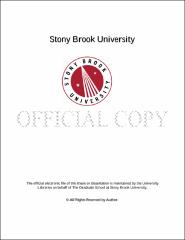| dc.identifier.uri | http://hdl.handle.net/11401/76309 | |
| dc.description.sponsorship | This work is sponsored by the Stony Brook University Graduate School in compliance with the requirements for completion of degree. | en_US |
| dc.format | Monograph | |
| dc.format.medium | Electronic Resource | en_US |
| dc.language.iso | en_US | |
| dc.publisher | The Graduate School, Stony Brook University: Stony Brook, NY. | |
| dc.type | Thesis | |
| dcterms.abstract | In conventional annular dark-field scanning transmission electron microscopy, the beam rasters on a thin sample and the signal map by integrating the transmitted electrons with an annular shaped detector in the diffraction space. Because the scattering cross sections for high-angle scattered electrons is proportional to the atomic number square. The resulting image has a so called Z-contrast. Z-contrast images can give atomic resolution images of atomic columns however it has an inherent problem—light elements buried in the tails of the heavy elements containing columns. In this thesis, we propose to use a pixelated a 2-D imaging detector to record the full CBED pattern at each beam position. This position-dependent coherent CBED map allows scattering intensities to be digitally integrated or subtracted from any parts of the diffraction space. In principle, if there is no noise, it can replace all detectors inside the microscope. The coherent CBED mapping data (x-y-kx-ky, namely 4-D inline holography) can also be used to achieve symmetry dependent sub-lattice imaging. For example, in ABO3 systems, it is possible to design an optimal transformation matrix (i.e. an digital detector function D(kx,ky)) to specifically image scattered electrons from A site cations only. The detector function can be further optimized to improve the signal-v.s.-thickness linearity. This problem can be mapped to a matrix inversion problem. Due to the size of the problem, it is more efficient to use data mining to construct an initial guess and then use conjugate gradient method to search for the best solution. Accomplishing this technique gives unique capability in imaging light elements, for instance measuring the degree of charge of lithium ion battery electrodes. | |
| dcterms.abstract | In conventional annular dark-field scanning transmission electron microscopy, the beam rasters on a thin sample and the signal map by integrating the transmitted electrons with an annular shaped detector in the diffraction space. Because the scattering cross sections for high-angle scattered electrons is proportional to the atomic number square. The resulting image has a so called Z-contrast. Z-contrast images can give atomic resolution images of atomic columns however it has an inherent problem—light elements buried in the tails of the heavy elements containing columns. In this thesis, we propose to use a pixelated a 2-D imaging detector to record the full CBED pattern at each beam position. This position-dependent coherent CBED map allows scattering intensities to be digitally integrated or subtracted from any parts of the diffraction space. In principle, if there is no noise, it can replace all detectors inside the microscope. The coherent CBED mapping data (x-y-kx-ky, namely 4-D inline holography) can also be used to achieve symmetry dependent sub-lattice imaging. For example, in ABO3 systems, it is possible to design an optimal transformation matrix (i.e. an digital detector function D(kx,ky)) to specifically image scattered electrons from A site cations only. The detector function can be further optimized to improve the signal-v.s.-thickness linearity. This problem can be mapped to a matrix inversion problem. Due to the size of the problem, it is more efficient to use data mining to construct an initial guess and then use conjugate gradient method to search for the best solution. Accomplishing this technique gives unique capability in imaging light elements, for instance measuring the degree of charge of lithium ion battery electrodes. | |
| dcterms.available | 2017-09-20T16:50:00Z | |
| dcterms.contributor | Raghothamachar, Balaji | en_US |
| dcterms.contributor | Xin, Huolin | en_US |
| dcterms.contributor | Gersappe, Dilip. | en_US |
| dcterms.creator | Huang, Guanzhong | |
| dcterms.dateAccepted | 2017-09-20T16:50:00Z | |
| dcterms.dateSubmitted | 2017-09-20T16:50:00Z | |
| dcterms.description | Department of Materials Science and Engineering. | en_US |
| dcterms.extent | 39 pg. | en_US |
| dcterms.format | Monograph | |
| dcterms.format | Application/PDF | en_US |
| dcterms.identifier | http://hdl.handle.net/11401/76309 | |
| dcterms.issued | 2015-12-01 | |
| dcterms.language | en_US | |
| dcterms.provenance | Made available in DSpace on 2017-09-20T16:50:00Z (GMT). No. of bitstreams: 1
Huang_grad.sunysb_0771M_12363.pdf: 9648978 bytes, checksum: 0ab7ca320dbaeb8c8b3c346463b7dd92 (MD5)
Previous issue date: 1 | en |
| dcterms.publisher | The Graduate School, Stony Brook University: Stony Brook, NY. | |
| dcterms.subject | Materials Science | |
| dcterms.title | Theoretical Investigation of Sub-lattice Imaging by 4-D In-line Holography | |
| dcterms.type | Thesis | |

